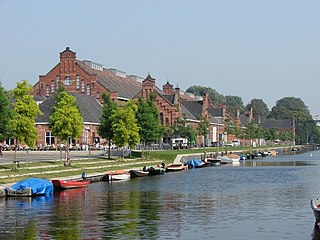
Buren is a town and municipality in the Betuwe region of the Netherlands. Buren has 27,168 inhabitants as of 1 January 2022.

Wijchen is a municipality and a town in the province of Gelderland, in the eastern part of the Netherlands.

Sittard is a city in the Netherlands, situated in the southernmost province of Limburg.

Huissen is a city with city rights in the Netherlands, in the province of Gelderland. The town is located in the Betuwe region and belongs to the municipality of Lingewaard, in the area between the major cities of Arnhem and Nijmegen. Huissen is situated along the rivers Nederrijn and Linge. The city has a population of 19,414.

Oosterbeek is a village in the eastern part of Netherlands. It is located in the municipality of Renkum in the province of Gelderland, about 5 km (3.1 mi) west of Arnhem.

Voorburg is a town and former municipality in the west part of the province of South Holland, Netherlands. Together with Leidschendam and Stompwijk, it makes up the municipality Leidschendam-Voorburg. It has a population of about 39,000 people. It is considered to be the oldest city in The Netherlands and celebrated its 2000th year of existence in 1988. However in Holland the status of 'city' normally commenced with the bestowing of a 'city charter' by its sovereign leader(s) and none available is that old. Human occupation has certainly been established as occurring two millennia ago, where Voorburg is located now. In 2002, the cities of Leidschendam and Voorburg were merged under the new municipality named "Leidschendam-Voorburg". Situated adjacent to the city of The Hague, it is often regarded as one of its suburbs.

Drakensteyn Castle is a small castle at 8 Slotlaan in the hamlet of Lage Vuursche, in the municipality of Baarn, Netherlands. It is the private residence of Princess Beatrix of the Netherlands, the country's former Queen.

Hillegersberg is a neighbourhood of Rotterdam, Netherlands. Primarily a green residential area with lakes, canals and parks, it was incorporated into the city of Rotterdam in 1941. Settlement around its Hillegonda church was first established here in 990.

The Sparta Stadion, nicknamed Het Kasteel is a football stadium in Rotterdam, Netherlands. It is the home ground of Sparta Rotterdam. It has a capacity of 11,026.

Hofwijck is a mansion built for 17th-century politician Constantijn Huygens. It is located in Voorburg on the Vliet canal from The Hague to Leiden. Formal address of the cultural heritage is 2 Westeinde, Voorburg, the Netherlands, but its location today is better known as the Voorburg railway station.

A rijksmonument is a national heritage site of the Netherlands, listed by the agency Rijksdienst voor het Cultureel Erfgoed (RCE) acting for the Dutch Ministry of Education, Culture and Science.

Rijksdienst voor het Cultureel Erfgoed often abbreviated as Cultureel Erfgoed, is a Dutch heritage organisation working for the protection and conservation of National Heritage Sites. It is located in Amersfoort, province of Utrecht.

The Huygens Institute for the History of the Netherlands was formed on January 1, 2011, through a merger of the Institute of Dutch History a research institute of the Netherlands Organisation for Scientific Research, and the Huygens Instituut of the Royal Netherlands Academy of Arts and Sciences. The institute is located in Amsterdam, Netherlands, in the Spinhuis building.
Maele Castle, Bruges Maele Castle is a former castle in Male, once a separate village, now part of Sint-Kruis, a suburb of Bruges, West Flanders, Belgium. The buildings, almost entirely rebuilt and restored after the destruction of World War II, have housed St. Trudo's Abbey (Sint-Trudoabdij) from 1954 until 2011.

The Westergasfabriek is a former gasworks in Amsterdam, the Netherlands, now used as a cultural venue.

Ammersoyen Castle is located in Ammerzoden in the Bommelerwaard region in the province of Gelderland, the Netherlands. When the original construction of the castle occurred is unclear; some sources claim it was as early as the 12th century. However, the consensus among historians is that the Van Herlaer family completed the castle in the 1350s. At the time of its construction, the castle was built along a branch of the river Maas. Just a few years after the construction of the castle was completed, the river was rerouted leaving the castle to be surrounded by a moat.

Jhr. Christaan Diederik Emerens Johan Bangeman Huygens was a Dutch diplomat and civil servant, from 1825 to 1832 Minister Plenipotentiary of the Kingdom of the Netherlands in Washington, DC.

Maurick Castle is a castle in Vught, Netherlands. It had many famous owners and visitors.

Sint-Michielsgestel is a village in the municipality of Sint-Michielsgestel, Netherlands.

The Carmelite Monastery in Echt, in the province of Limburg, the Netherlands, also known as the Echt Carmel, is a community of Discalced Carmelite nuns established in 1879.



















